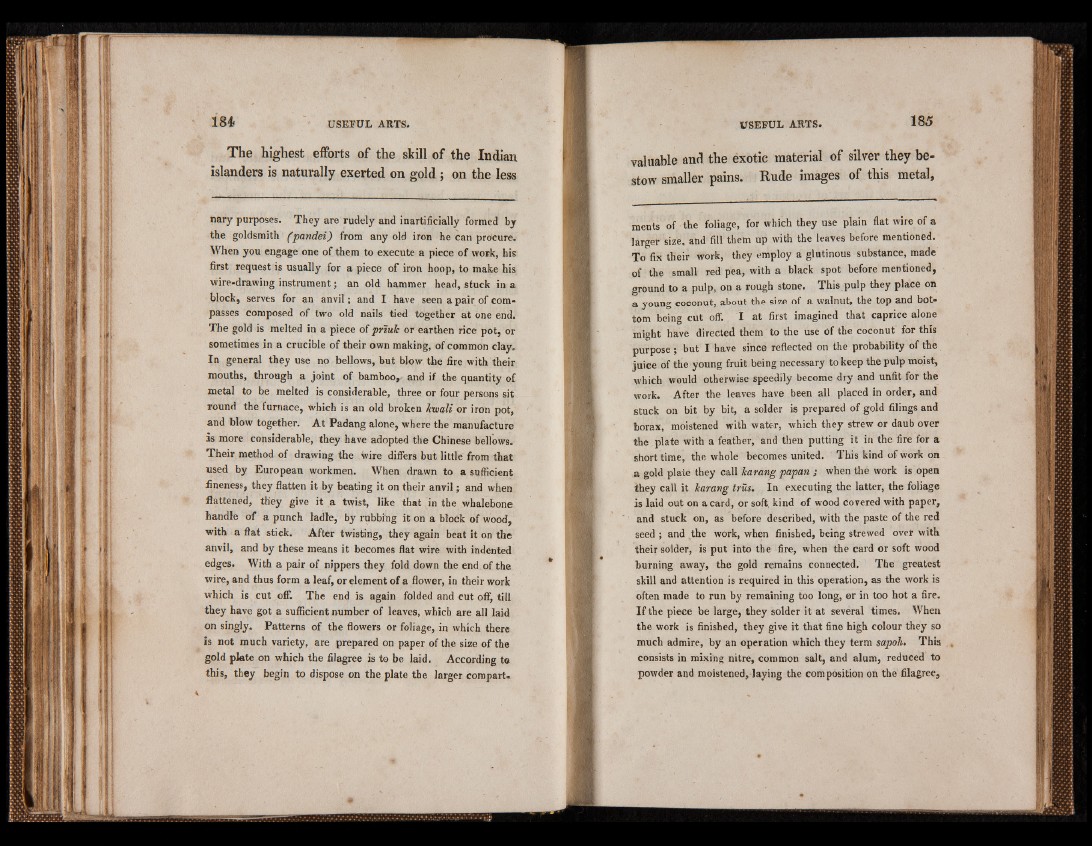
The highest efforts of the skill of the Indian
islanders is naturally exerted on gold ; on the less
nary purposes. They are rudely and inartificially formed by
the goldsmith ( pandei) from any old iron he can procure.
When you engage one of them to execute a piece of work, his
first request is usually for a piece of iron hoop, to make his
wire-drawing instrument; an old hammer head, stuck in a
block, serves for an anvil; and I have seen a pair of compasses
composed of two old nails tied together at one end.
The gold is melted in a piece of priuk or earthen rice pot, or
sometimes in a crucible of their own making, of common clay.
In general they use no bellows, but blow the fire with their
mouths, through a joint of bamboo*- and if the quantity of
metal to be melted is considerable, three or four persons sit
round the furnace, which is an old broken lewali or iron pot,
and blow together. At Padang alone, where the manufacture
is more considerable, they have adopted the Chinese bellows.
Their method of drawing the wire differs but little from that
used by European workmen. When drawn to a sufficient
fineness, they flatten it by beating it on their anvil; and when
flattened, they give it a twist, like that in the whalebone
handle of a punch ladle, by rubbing it on a block of wood,
with a flat stick. After twisting, they again beat it on the
anvil, and by these means it becomes flat wire with indented
edges. With a pair of nippers they fold down the end of the
wire, and thus form a leaf, or element of a flower, in their work
which is cut off. The end is again folded and cut off, till
they have got a sufficient number of leaves, which are all laid
on singly. Patterns of the flowers or foliage, in which there
is not much variety, are prepared on paper of the size of the
gold p k te on which the filagree is to be laid. According to
this, they begin to dispose on the plate the larger compart«
valuable and the exotic material of silver they bestow
smaller pains. Rude images of this metal,
ments of the foliage, for which they use plain flat wire of a
larger size, ahd fill them up with the leaves before mentioned.
To fix their work, they employ a glutinous substance, made
of the small red pea, with a black spot before mentioned,
ground to a pulp, on a rough stone. This pulp they place on
a young coconut, about the size of a walnut, the top and bottom
being cut off. I at first imagined that caprice alone
might have directed them to the use of the coconut for this
purpose ; but I have since reflected on the probability of the
juice of the young fruit being necessary to keep the pulp moist,
which would otherwise speedily become dry and unfit for the
work. After the leaves have been all placed in order, and
stuck on bit by bit, a solder is prepared of gold filings and
borax, moistened with water, which they strew or daub over
the plate with a feather, and then putting it in the fire for a
short time, the whole becomes united. This kind of work on
a gold plate they call Jcarang papan ; when the work is open
they call it Icarang tries. In executing the latter, the foliage
is laid out on a card, or soft, kind of wood Covered with paper,
and stuck on, as before described, with the paste of the red
seed ; and the work, when finished, being strewed over with
their solder, is put into the fire, when the card or soft wood
burning away, the gold remains connected. The greatest
skill and attention is required in this operation, as the work is
often made to run by remaining too long, or in too hot a fire.
I f the piece be large, they solder it at several times. When
the work is finished, they give it that fine high colour they so
much admire, by an operation which they term sapoh. This
consists in mixing nitre, common salt, and alum, reduced to
powder and moistened, laying the composition on the filagree,